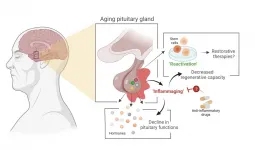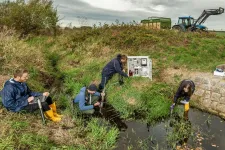(Press-News.org) Researchers have identified two subgroups of adolescents who self-harm and have shown that it is possible to predict those individuals at greatest risk almost a decade before they begin self-harming.
The team, based at the MRC Cognition and Brain Sciences Unit, University of Cambridge, found that while sleep problems and low self-esteem were common risk factors, there were two distinct profiles of young people who self-harm - one with emotional and behavioural difficulties and a second group without those difficulties, but with different risk factors.
Between one in five and one in seven adolescents in England self-harms, for example by deliberately cutting themselves. While self-harm is a significant risk factor for subsequent suicide attempts, many do not intend suicide but face other harmful outcomes, including repeatedly self-harming, poor mental health, and risky behaviours like substance abuse. Despite its prevalence and lifelong consequences, there has been little progress in the accurate prediction of self-harm.
The Cambridge team identified adolescents who reported self-harm at age 14, from a nationally representative UK birth cohort of approximately 11,000 individuals. They then used a machine learning analysis to identify whether there were distinct profiles of young people who self-harm, with different emotional and behavioural characteristics. They used this information to identify risk factors from early and middle childhood. The results are published in the Journal of the American Academy of Child and Adolescent Psychiatry.
Because the data tracked the participants over time, the researchers were able to distinguish factors that appear alongside reported self-harm behaviour, such as low self-esteem, from those that precede it, such as bullying.
The team identified two distinct subgroups among young people who self-harm, with significant risk factors present as early as age five, nearly a decade before they reported self-harming. While both groups were likely to experience sleep difficulties and low self-esteem reported at age 14, other risk factors differed between the two groups.
The first group showed a long history of poor mental health, as well as bullying before they self-harmed. Their caregivers were more likely to have mental health issues of their own.
For the second group, however, their self-harming behaviour was harder to predict early in childhood. One of the key signs was a greater willingness to take part in risk-taking behaviour, which is linked to impulsivity. Other research suggests these tendencies may predispose the individual towards spending less time to consider alternate coping methods and the consequences of self-harm. Factors related to their relationships with their peers were also important for this subgroup, including feeling less secure with friends and family at age 14 and a greater concern about the feelings of others as a risk factor at age 11.
Stepheni Uh, a Gates Cambridge Scholar and first author of the study, said: "Self-harm is a significant problem among adolescents, so it's vital that we understand the nuanced nature of self-harm, especially in terms of the different profiles of young people who self-harm and their potentially different risk factors.
"We found two distinct subgroups of young people who self-harm. The first was much as expected - young people who experience symptoms of depression and low self-esteem, face problems with their families and friends, and are bullied. The second, much larger group was much more surprising as they don't show the usual traits that are associated with those who self-harm."
The researchers say that their findings suggest that it may be possible to predict which individuals are most at risk of self-harm up to a decade ahead of time, providing a window to intervene.
Dr Duncan Astle said: "The current approach to supporting mental health in young people is to wait until problems escalate. Instead, we need a much better evidence base so we can identify who is at most risk of mental health difficulties in the future, and why. This offers us the opportunity to be proactive, and minimise difficulties before they start.
"Our results suggest that boosting younger children's self-esteem, making sure that schools implement anti-bullying measures, and providing advice on sleep training, could all help reduce self-harm levels years later.
"Our research gives us potential ways of helping this newly-identified second subgroup. Given that they experience difficulties with their peers and are more willing to engage in risky behaviours, then providing access to self-help and problem-solving or conflict regulation programmes may be effective."
Professor Tamsin Ford from the Department of Psychiatry added: "We might also help at-risk adolescents by targeting interventions at mental health leaders and school-based mental health teams. Teachers are often the first people to hear about self-harm but some lack confidence in how to respond. Providing them with training could make a big difference."
INFORMATION:
The research was supported by the Gates Cambridge Trust, Templeton World Charity Foundation, and the UK Medical Research Council.
Reference
Uh, S et al. Two pathways to self-harm in adolescence. Journal of the American Academy of Child and Adolescent Psychiatry; DOI: 10.1016/j.jaac.2021.03.010
A new study by Newcastle University shows that the risk of dolphins and porpoises being caught in small-scale (artisanal) fisheries is highest in low- and middle-income regions around the tropics and sub-tropics.
Marine scientists assessed the risk posed by small-scale fisheries to all 72 species of toothed whales found throughout the world's oceans. They found that this risk was highest in the Central Indo-Pacific, Temperate Northern Pacific, Temperate South America and the Western Indo-Pacific.
Publishing their findings in the journal Fish and Fisheries, the authors ...
Stem cell biologist Hugo Vankelecom (KU Leuven) and his colleagues have discovered that the pituitary gland in mice ages as the result of an age-related form of chronic inflammation. It may be possible to slow down this process or even partially repair it. The researchers have published their findings in PNAS.
The pituitary gland is a small, globular gland located underneath the brain that plays a major role in the hormonal system, explains Professor Hugo Vankelecom from the Department of Development and Regeneration at KU Leuven. "My research group discovered that the pituitary gland ages as a result of a form of chronic inflammation that affects tissue and even the organism as a whole. This natural process usually goes unnoticed ...
The inclusion of biological uncertainty and the latest case data can significantly improve the prediction accuracy of standard epidemiological models of virus transmission, new research led by KAUST and the Kuwait College of Science and Technology (KCST) has shown.
Modern mathematical epidemic models have been tested like never before during the COVID-19 pandemic. These models use mathematics to describe the various biological and transmission processes involved in an epidemic. However, when such factors are highly uncertain, such as during the emergence of a new virus like COVID-19, the predictions ...
Local rice varieties in Vietnam could be used to help breed improved crops with higher resilience to climate change, according to a new study published in Rice.
Earlham Institute researchers are part of an international collaboration with genebanks and rice breeders in Vietnam - championed by the International Rice Research Institute (IRRI) to help abolish world poverty and hunger - are aiming to identify varieties that can survive an increasingly unpredictable climate.
The new genomic data they have generated will significantly support efforts to ...
Pesticides safeguard agricultural yields by controlling harmful insects, fungi, and weeds. However, they also enter neighbouring streams and damage the aquatic communities, which are crucial for maintaining biodiversity, are part of the food web and support the self-purification of water. In a nationwide monitoring programme, a consortium of scientists led by the Helmholtz Centre for Environmental Research (UFZ) has shown that the governmental thresholds for pesticides are generally too high and that even these excessively high levels are still exceeded in over 80% of water bodies. As they published in the scientific journal Water Research the loss of biodiversity can only be halted if the environmental risk assessment ...
New research led by the University of Kent has found that there is no link between bed sharing, infant-mother attachment, and infant behavioural outcomes.
Contrary to previous beliefs that bed sharing is beneficial (or even required) for babies to develop a secure attachment style and for mothers to develop a strong bond to their baby, researchers have found that it is neither associated with positive or negative outcomes related to infant attachment and maternal bonding.
There is a lot of controversial debate about bed sharing by parents and the infant sleep literature, in particular. Notably, researchers and practitioners recommend against bed sharing, particularly before four months of age due to the increased risk of Sudden Infant Death Syndrome (SIDS).
In reality, ...
The influx of warmer water masses from the North Atlantic into the European marginal seas plays a significant role in the marked decrease in sea-ice growth, especially in winter. Sea-ice physicists from the Alfred Wegener Institute, Helmholtz Centre for Polar and Marine Research (AWI) together with researchers from the US and Russia, now present evidence for this in two new studies, which show that heat from the Atlantic has hindered ice growth in the Barents and Kara Seas for years. Furthermore, they demonstrate that the invasion of warm Atlantic water masses further east, ...
The research - published ahead of World Day to Combat Desertification and Drought on 17 June 2021 - examines recent and projected climate change impacts on water security across the world's drylands up to the year 2100.
It concludes that more efficient water management, technology and infrastructure, and better demand and supply management can offer more equitable access to water resources and help to achieve development goals.
Lead author, Professor Lindsay Stringer from the Department of Environment and Geography at the University of York said "People in dryland areas are already adapting to climate changes, but they need to be supported with coherent system-oriented policies and institutions that put water security at their core."
Globally, water scarcity already affects ...
Below please find link(s) to new coronavirus-related content published today in Annals of Internal Medicine. All coronavirus-related content published in Annals of Internal Medicine is free to the public. A complete collection is available at https://annals.org/aim/pages/coronavirus-content.
1. NFL employee and player surveillance program enabled early detection of COVID-19, even among those who were asymptomatic
Free full text: https://www.acpjournals.org/doi/10.7326/M21-0319
Frequent, routine testing within the National Football League (NFL) enabled early detection of COVID-19 infection among players and ...
In a study published today in the Annals of Internal Medicine, Johns Hopkins Medicine researchers say they believe that, for the first time, there is evidence to show that three doses of vaccine increase antibody levels against SARS-CoV-2 -- the virus that causes COVID 19 -- more than the standard two-dose regimen for people who have received solid organ transplants.
"Our findings suggest clinical trials are warranted to determine if transplant recipients should receive COVID-19 vaccine booster doses as standard clinical practice, similar to what ...






